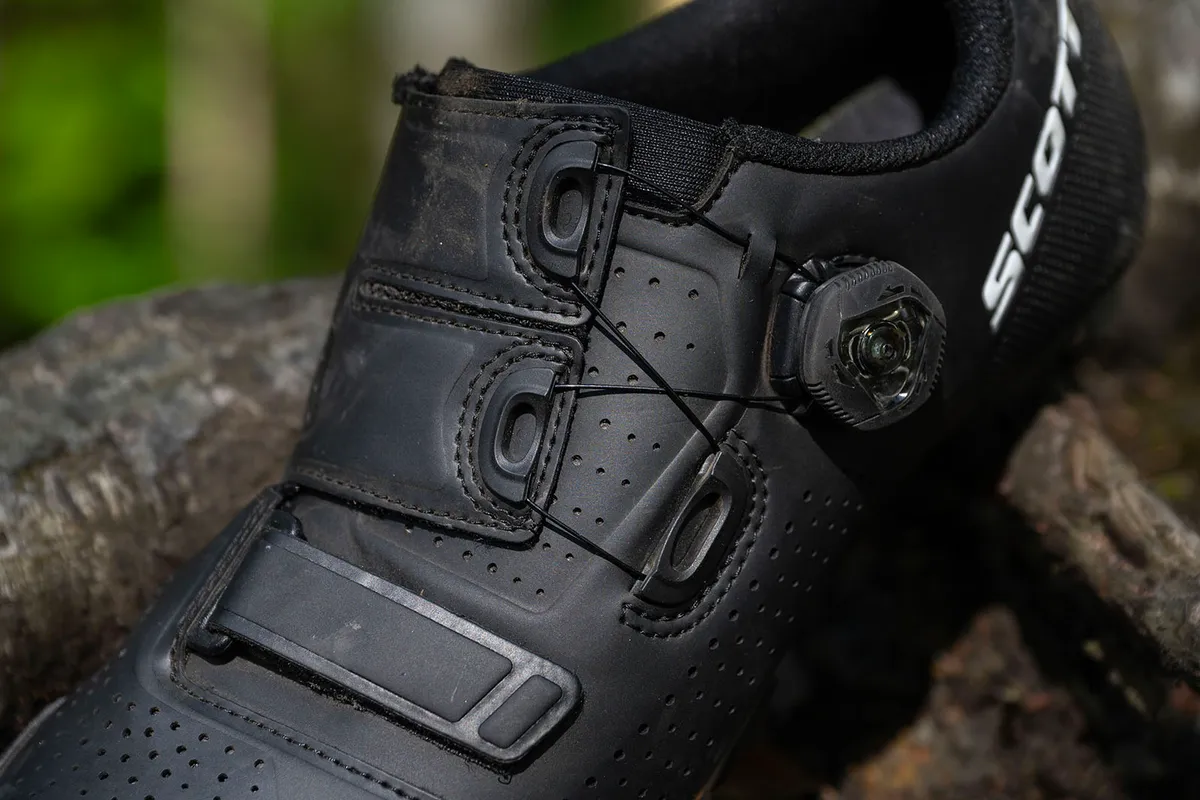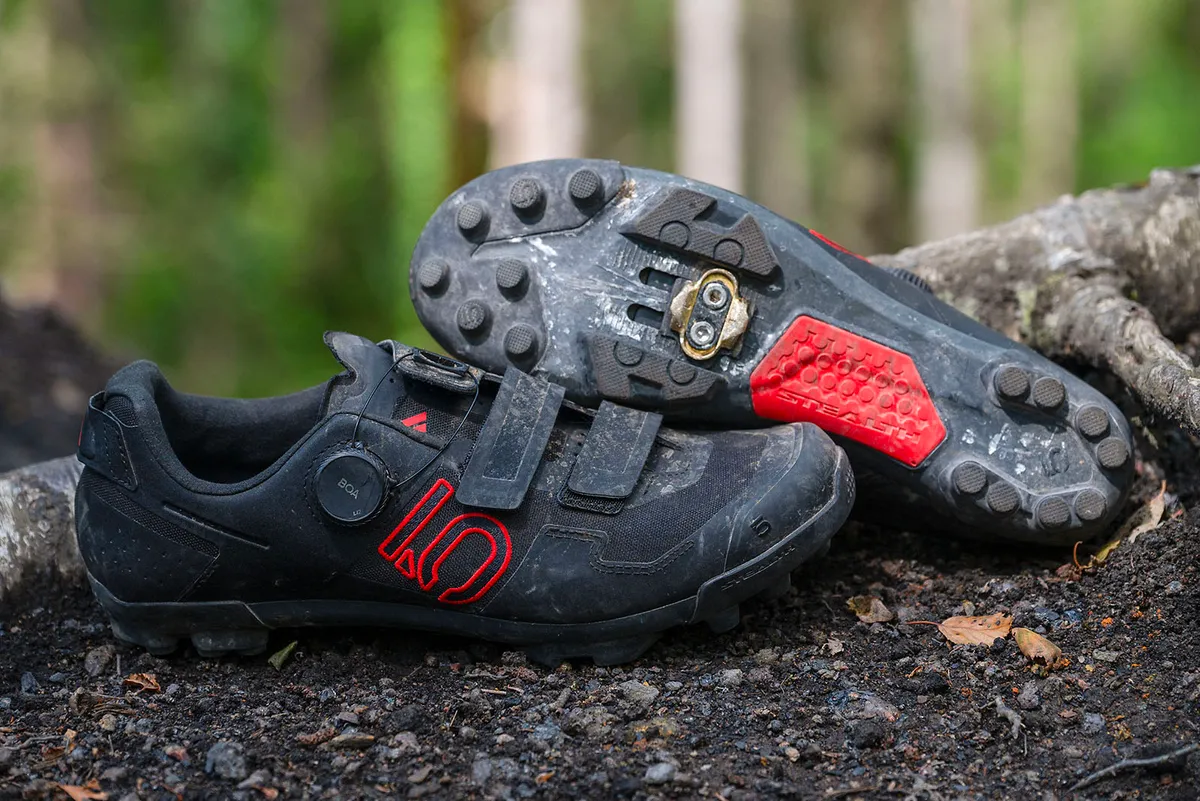Scott’s shoes have a good reputation for blending fit and function with an agreeable price tag.
The MTB Team BOA shoes are no exception, thanks to the impressive fit and comfort levels, as well as their reasonably stiff sole that makes a real difference when you’re putting the power down.
Limited cleat adjustment holds them back somewhat, but these mountain bike shoes from Scott are still impressive, despite this rather fundamental flaw.
Scott MTB Team BOA shoes specifications and details

Where the Team BOA shoes really win a lot of points is thanks to the closure system.
Instead of using a Boa ratchet dial to tighten a wire that zig zags across the top of the foot, Scott employs the indexed dial a little differently. Yes, it’s still winding in a wire, but the wire is attached to a broad flap that spans about half the length of the upper.
This, helps to create a more even tension across the top of the foot, avoiding those pesky hot spots that can be common with single Boa closures.
An additional Velcro strap sits just above the toe box to cinch in any additional excess material for a firmer fit.
A mix of perforations and a mesh panel help to keep the Team BOAs airier on warmer days, while ample padding around the heel and ankle cuff improve fit and bolster comfort.

There’s a reinforced toe bumper, though it remains relatively malleable compared to others I’ve tested, suggesting this is more about boosting the shoe’s durability rather than all-out toe protection.
Scott scores the outsole an eight on its stiffness index (though it doesn't say what that score is out of). The stiffness comes courtesy of the nylon/glass fibre composite mid-sole.
The cleat slots are surrounded by alignment markers (there are even angled reference lines to use) in a bid to make cleat setup more accurate and repeatable.
Surrounding the outside are the pronounced, rather firm tread blocks, along with two removable screw-in toe studs.
At 720g (size EU 42 with Crankbrothers cleats fitted), they’re fairly light shoes.
Scott MTB Team BOA shoes performance

While it’s great to have the plethora of alignment markers either side and in-between the two cleat slots, cleat setup was trickier than I anticipated.
The simple reason for this was down to the shiny, hard, slick surface you’re attaching the cleat to. Every time I tried to torque the Crankbrothers cleats down tightly (onto the plastic spacers that sit beneath them), they’d twist a little.
I managed to finally remedy this by wedging things either side of the cleat to prevent it from spinning, but it took longer than expected.
The other issue I have with the cleat setup is Scott doesn’t offer enough rearward adjustment. I simply couldn’t get the cleats back far enough on the shoes.
This didn’t really cause any issues when sat down and pedalling along flat singletrack or when climbing. However, when standing up out of the saddle on the descents, I felt as though I was stood up on the balls of my feet, causing my legs to fatigue more quickly.
I realise this sounds very negative, but despite these traits, I otherwise really liked wearing the Team BOA shoes.
That was primarily down to how comfortable the upper felt, thanks in part to how the closure is able to clamp the shoes solidly onto your feet.

Even with the BOA dial cranked right up, I never suffered any pinch points or hot spots on my feet. Instead, they felt perfectly secure inside the shoes. Even when really pulling up on my pedals during high-power efforts, my feet didn’t lift or shift inside the shoes.
This was helped further by the padding and forming around the heels, which adds to the overall fit, hugging the back of your feet and leaving them feeling well-supported.
And let’s not forget the insole. There’s some subtle arch support that feels very natural and didn’t cause any issues on longer rides.
The relatively stiff outsole enables you to really mash at the pedals (including smaller cross-country style clipless pedals) with next to no unwanted flex. There is a bit of give from the sole, but it doesn’t cause any discomfort, even when stood up out of the saddle and climbing for prolonged periods.
If you do struggle to clip in and need to rest the Team BOAs on the pedals, the hard plasticky outsole is very skatey, though.
Off the bike, there’s a bit of toe flex, which helps you walk a little more naturally, but the hard tread and studs can feel sketchy on firmer surfaces.
How do the Scott MTB Team BOA shoes compare?

I tested the Scott MTB Team BOA shoes as part of a bigger group test, which also included the Five Ten Kestrel BOA.
Although the Five Tens are £50 more expensive, I’d say they’re worth the extra investment.
While the Scotts can easily go toe-to-toe with the Five Tens when it comes to stiffness and fit, the Five Tens have the edge elsewhere.
Firstly, they offer the potential of getting your cleats set farther back on the shoes. It's a big win for me and something that should help keep your legs fresher on the descents, as I found to be the case.
They also offer a patch of grippier rubber behind the cleat pocket just in case you find yourself unclipped and balancing on the pedals. It’s a small feature but makes a huge difference during those heat-of-the-moment scenarios.
The toe bumper is sturdier, and feels just as secure and locked-in as the Scott’s. It's also a touch more comfortable and perhaps slightly better at getting the power down through the pedals.
Scott MTB Team BOA shoes bottom line

Despite the fact that I couldn’t get my cleats as far back in the Team BOA shoes as I’d have liked, I still really enjoyed riding in them.
That’s largely down to how comfortable they are. That, in turn, is thanks in part to the flexible upper and impressive closure system that properly clamps the shoes onto your feet without any discomfort, no matter how hard you’re pushing at the pedals.
The stiff sole makes for an efficient feel on the pedals, too, though the firm tread and studs make walking on harder surfaces a little dicey at times.
If you’re keen on racking up massive mile counts in comfort, the Scott MTB Team BOA shoes are certainly worth considering.
How we tested | trail and XC clipless mountain bike shoes
We've tested nine of the newest and most interesting trail and cross-country focused clipless shoes.
To identify the key differences, we’ve gone out into the wilderness to pedal mile after mile, often with a different shoe on each foot. This may look weird, but there’s no better way to highlight those all-important details.
On top of that, doing long rides around battered trail centre loops and taking part in an XC race has helped us work out each pair’s strengths and weaknesses.
Products on test
- Bontrager Evoke
- Five Ten Kestrel Boa
- Fizik Terra Atlas
- Giro Rincon
- Northwave Rockit Plus
- Rockrider Race 700
- Scott MTB Team Boa
- Shimano ME5
- Specialized Recon 2.0
Product
| Brand | Scott |
| Price | A$250.00, €160.00, £150.00, $170.00 |
| Weight | 720g |
Features
| Shoe closure | dial |
| Sole | Thermo Polyurethane |
| Features | Sizes: 6.5 - 12.5 UK Upper: Microfiber - Polyester Midsole: Nylon Composite - Glass Fiber Composite Colours: Matt Black/White, Black Fade/Metallic Blue |
